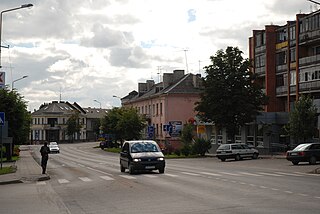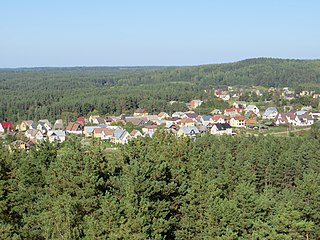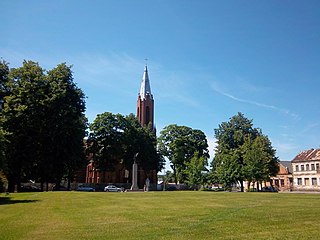
Vištytis is a small town in Marijampolė County, Vilkaviškis District Municipality in southwestern Lithuania on the border with Russia and close to the border with Poland. It is the administrative center of Vištytis eldership (seniūnija).

Joniškis is a city in northern Lithuania with a population of about 9,900. It is located 39 kilometers north of Šiauliai and 14 kilometers south of the Lithuania–Latvia border. Joniškis is the municipal and administrative centre of Joniškis district municipality.

Alytus is a city with municipal rights in southern Lithuania. It is the capital of Alytus County. The population as of July 2024 was 50,996. Alytus is the historical centre of the Dzūkija region. The city lies on the banks of the Nemunas river. The major roads linking Vilnius, Kaunas, Lazdijai, and Grodno in Belarus pass through Alytus.

Plungė is a city in Lithuania with 17,252 inhabitants. Plunge is the capital of the Plungė District Municipality which has 33,251 inhabitants (2022). Two parts of the city are separated by the Babrungas River and two bridges are built over it.

Molėtai is a city in north eastern Lithuania surrounded by lakes. One of the oldest settlements in Lithuania, it is a popular resort for the inhabitants of Vilnius. According to the 2013 census, it had 6,302 inhabitants.

Ignalina is a city in eastern Lithuania. It is known as a tourist destination in the Aukštaitija National Park. Ignalina is also famous for the now decommissioned Ignalina Nuclear Power Plant in nearby Visaginas.

Skuodas is a city located in Klaipėda County, in northwestern Lithuania, on the border with Latvia. The Bartuva river flows through the town. Is currently the capital of Skuodas District Municipality.

Lazdijai is a city (miestas) in Lithuania located about seven kilometres east of the border with Poland.

Žiežmariai is a town in the Kaišiadorys district municipality, Lithuania. It is located 6 km (3.7 mi) south of Kaišiadorys. The center of Žiežmariai is a state-protected urbanistic monument.

Šeduva is a town in the Radviliškis district municipality, Lithuania. It is located 18 km (11 mi) east of Radviliškis.

Kudirkos Naumiestis is a town in southern Lithuania. It is located 25 km (16 mi) south-west of Šakiai.

Subačius is a small town in Panevėžys County, northwestern Lithuania. It is located on the banks of the Viešinta River about 14 km (8.7 mi) west of Kupiškis.

The Ponary massacre, or the Paneriai massacre, was the mass murder of up to 100,000 people, mostly Jews, Poles, and Russians, by German SD and SS and the Lithuanian Ypatingasis būrys killing squads, during World War II and the Holocaust in the Generalbezirk Litauen of Reichskommissariat Ostland. The murders took place between July 1941 and August 1944 near the railway station at Ponary, a suburb of today's Vilnius, Lithuania. 70,000 Jews were murdered at Ponary, along with up to 2,000 Poles, 8,000 Soviet POWs, most of them from nearby Vilnius, and its newly formed Vilna Ghetto.

Kruonis is a small town, located 37 km (23 mi) east of Kaunas, in Kaunas County, central Lithuania. The name of Kruonis comes from a small creek Kruonė. In 2011 it had a population of 661. The center of Kruonis is a state-protected urbanistic monument. The only in the Baltic States Kruonis Pumped Storage Plant is situated 3 km (1.9 mi) north of Kruonis. Each year a music festival Renesanso naktys Kruonyje takes place in the church where the classical music of the composers of 16th-17th centuries being performed.

Žasliai is a small town in Kaunas County in central Lithuania. In 2011, it had a population of 644. The town was first mentioned in written sources in 1457 and was granted the Magdeburg rights and its own coat of arms in 1792.

Žemaičių Naumiestis is a town in Klaipėda county, Šilutė district municipality in western Lithuania, between Klaipėda and Kaliningrad Oblast. The rivers Šustis, Šelmuo and Lendra flow through it.

Vyžuonos is a town in Utena County, Lithuania. According to the 2011 census, the town has a population of 512 people.

Darsūniškis is a settlement on the Nemunas River in Kaišiadorys District Municipality, western Lithuania. The village is one of the oldest settlements in Lithuania and dates back to the 14th century.
The Plungė massacre was a World War II massacre committed on 13 or 15 July 1941 in the town of Plungė, in Lithuania. Following the anti-Soviet June Uprising in Lithuania and the German invasion as part of Operation Barbarossa, Plungė was captured by German forces on 25 June 1941. Lithuanian nationalists, led by Jonas Noreika, formed a town administration and police force. Lithuanians accused 60 young Jewish men of being a rear guard for the Red Army; shortly after the town's capture, German forces killed these men. On 13 or 15 July Lithuanian nationalists transported the Jews to ditches near the village of Kausenai where they were shot. Of the 1,700-1,800 remaining Jews of Plungė, only a few survived.

























